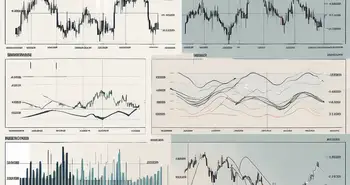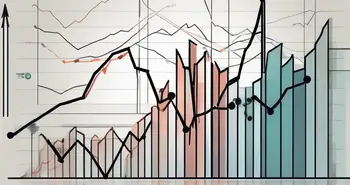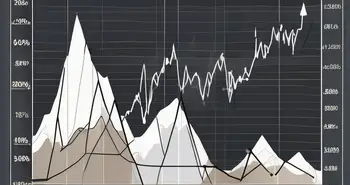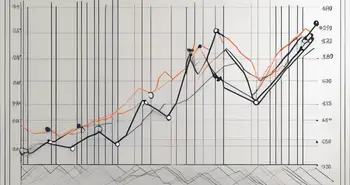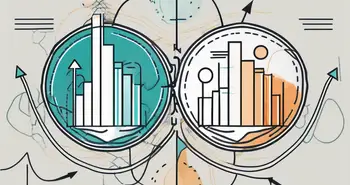Understanding the Volatility Ratio: A Comprehensive Guide

As a seasoned trader, I have come to appreciate the power of the volatility ratio in analyzing market trends and managing risk. In this comprehensive guide, I will walk you through the intricacies of this important trading tool, from its definition to its practical applications. Let's dive in!
Defining the Volatility Ratio
At its core, the volatility ratio is a statistical measure used to gauge the volatility or price movements of a particular security or market index. It is a widely accepted metric that enables traders to assess the level of risk associated with a given investment. By understanding the volatility ratio, traders can make more informed decisions and potentially increase their chances of success.
The Basics of Volatility Ratio
Before we delve into the mathematical aspects of the volatility ratio, it's important to grasp its fundamental concepts. Volatility, in simple terms, refers to the frequency and magnitude of price fluctuations in a security or market index. A high volatility ratio suggests that prices are moving erratically, indicating a higher level of risk. Conversely, a low volatility ratio indicates relatively stable price movements.
Understanding the basics of the volatility ratio is crucial for traders as it provides them with valuable insights into the behavior of a security or market index. By analyzing the frequency and magnitude of price fluctuations, traders can gain a better understanding of the potential risks and rewards associated with a particular investment. This knowledge allows them to make more informed decisions and develop effective trading strategies.
Moreover, the volatility ratio is not a standalone measure but rather a tool that is used in conjunction with other technical indicators. By combining the volatility ratio with other indicators such as moving averages or trend lines, traders can obtain a more comprehensive view of the market dynamics. This holistic approach helps them identify trends, patterns, and potential trading opportunities.
The Importance of Volatility Ratio in Trading
When it comes to trading, volatility is a double-edged sword. While it presents opportunities for profit, it also entails higher risks. By understanding and monitoring the volatility ratio, traders can assess the level of risk associated with a particular investment and adjust their strategies accordingly. It helps them identify potentially lucrative trades while minimizing the chances of incurring significant losses.
One of the key advantages of using the volatility ratio in trading is its ability to provide traders with a measure of market sentiment. By analyzing the volatility ratio, traders can gauge the overall market sentiment towards a particular security or market index. This information can be invaluable in predicting future price movements and making informed trading decisions.
Furthermore, the volatility ratio can also be used to identify potential market turning points. When the volatility ratio reaches extreme levels, it may indicate an overbought or oversold condition in the market. This can serve as a signal for traders to enter or exit positions, maximizing their profit potential.
Overall, the volatility ratio plays a crucial role in trading by providing traders with valuable insights into market dynamics and risk levels. By incorporating this metric into their analysis, traders can enhance their decision-making process and improve their overall trading performance.
The Mathematics Behind Volatility Ratio
Now that we have explored the basics, let's dive into the mathematical intricacies of the volatility ratio. To calculate the volatility ratio, one needs to determine the standard deviation of the price data over a specific time period. This standard deviation is then divided by the average price over the same period, resulting in the volatility ratio value.
Calculating the Volatility Ratio
To calculate the volatility ratio, you need to follow these steps:
- Gather the historical price data for the desired time period.
- Calculate the average price by summing up all the prices and dividing the sum by the number of data points.
- Calculate the standard deviation of the price data.
- Divide the standard deviation by the average price and multiply by 100 to obtain the volatility ratio value.
Interpreting the Volatility Ratio Values
Once you have calculated the volatility ratio value, it's essential to interpret its significance accurately. A value below 1 indicates relatively low volatility, implying a more stable and less risky market. On the other hand, a value above 1 suggests higher volatility, signaling greater price fluctuations and increased risk.
The Role of Volatility Ratio in Risk Management
Efficient risk management is a cornerstone of successful trading, and the volatility ratio plays a vital role in this aspect. Let's explore two key ways in which the volatility ratio contributes to effective risk management:
Volatility Ratio as a Risk Indicator
The volatility ratio acts as a valuable risk indicator by providing traders with a clear understanding of the level of risk associated with a particular security or market index. By monitoring the volatility ratio, traders can adjust their risk thresholds and position sizes accordingly, ensuring they stay within their risk tolerance levels.
Using Volatility Ratio for Portfolio Diversification
Diversification is a crucial strategy for mitigating risk in any investment portfolio. The volatility ratio can help traders identify assets that exhibit low correlation to their existing holdings. By incorporating assets with different volatility ratios into their portfolio, traders can achieve a more balanced risk profile and reduce the impact of adverse market movements.
Strategies for Trading with Volatility Ratio
Now that you have a comprehensive understanding of the volatility ratio, let's explore some strategies for incorporating it into your trading approach:
Timing the Market with Volatility Ratio
One strategy involves using the volatility ratio to help identify optimal entry and exit points in the market. By analyzing historical data and comparing current volatility levels, traders can pinpoint periods of high volatility and choose their trades accordingly. By entering the market during high volatility periods, traders can potentially capitalize on significant price movements.
Volatility Ratio and Stop-Loss Orders
Another effective strategy involves setting stop-loss orders based on the volatility ratio. By placing stop-loss orders at appropriate levels relative to the volatility ratio, traders can protect their capital from excessive losses during periods of heightened volatility. This approach allows traders to automatically exit a trade if the price deviates beyond a certain tolerance level.
Common Misconceptions About Volatility Ratio
Now, let's address some common misconceptions surrounding the volatility ratio:
Debunking Volatility Ratio Myths
Contrary to popular belief, high volatility ratio values do not necessarily indicate a bearish market or vice versa. The volatility ratio is merely a measure of price fluctuations and should be interpreted as a stand-alone metric. It is essential to analyze other market indicators and factors to gain a comprehensive understanding of the market's trajectory.
Understanding the Limitations of Volatility Ratio
While the volatility ratio provides valuable insights into market dynamics, it has its limitations. It is a backward-looking metric based on historical price data and may not account for sudden market shocks or unforeseen events. Traders should use the volatility ratio in conjunction with other technical and fundamental analysis tools for a well-rounded trading strategy.
As an expert trader, I have seen firsthand the power of the volatility ratio in guiding trading decisions and managing risk. By understanding its intricacies and leveraging its insights, you can enhance your trading edge and increase the likelihood of success. Happy trading!
FAQ
Let's revisit the main points covered in this comprehensive guide:
What is the volatility ratio?
The volatility ratio is a statistical measure that quantifies the volatility or price movements of a security or market index. It helps traders assess the level of risk associated with a particular investment.
How is the volatility ratio calculated?
The volatility ratio is calculated by dividing the standard deviation of price data by the average price over a specific time period and multiplying by 100.
How can I use the volatility ratio in risk management?
The volatility ratio can be used as a risk indicator and can guide position sizing and risk threshold decisions. It can also help identify assets for portfolio diversification.
What trading strategies can I employ with the volatility ratio?
Two popular strategies include timing the market by entering trades during periods of high volatility and setting stop-loss orders based on the volatility ratio.
What are the limitations of the volatility ratio?
The volatility ratio is a backward-looking metric based on historical price data. It may not account for sudden market shocks or unforeseen events, so it should be used in conjunction with other analysis tools.

Ready to put your knowledge of the volatility ratio to the test in a dynamic trading environment? Look no further than Morpher, the revolutionary trading platform that's changing the game with zero fees, infinite liquidity, and a host of innovative features like fractional investing, short selling, and up to 10x leverage. Experience the future of trading with Morpher's unique Virtual Futures on the Ethereum Blockchain, and take control of your investments with the secure Morpher Wallet. Sign Up and Get Your Free Sign Up Bonus today to start trading across a wide range of asset classes, including stocks, cryptocurrencies, forex, and more. Embrace a trading experience designed for the modern investor with Morpher.
Disclaimer: All investments involve risk, and the past performance of a security, industry, sector, market, financial product, trading strategy, or individual’s trading does not guarantee future results or returns. Investors are fully responsible for any investment decisions they make. Such decisions should be based solely on an evaluation of their financial circumstances, investment objectives, risk tolerance, and liquidity needs. This post does not constitute investment advice.

Painless trading for everyone
Hundreds of markets all in one place - Apple, Bitcoin, Gold, Watches, NFTs, Sneakers and so much more.

Painless trading for everyone
Hundreds of markets all in one place - Apple, Bitcoin, Gold, Watches, NFTs, Sneakers and so much more.

